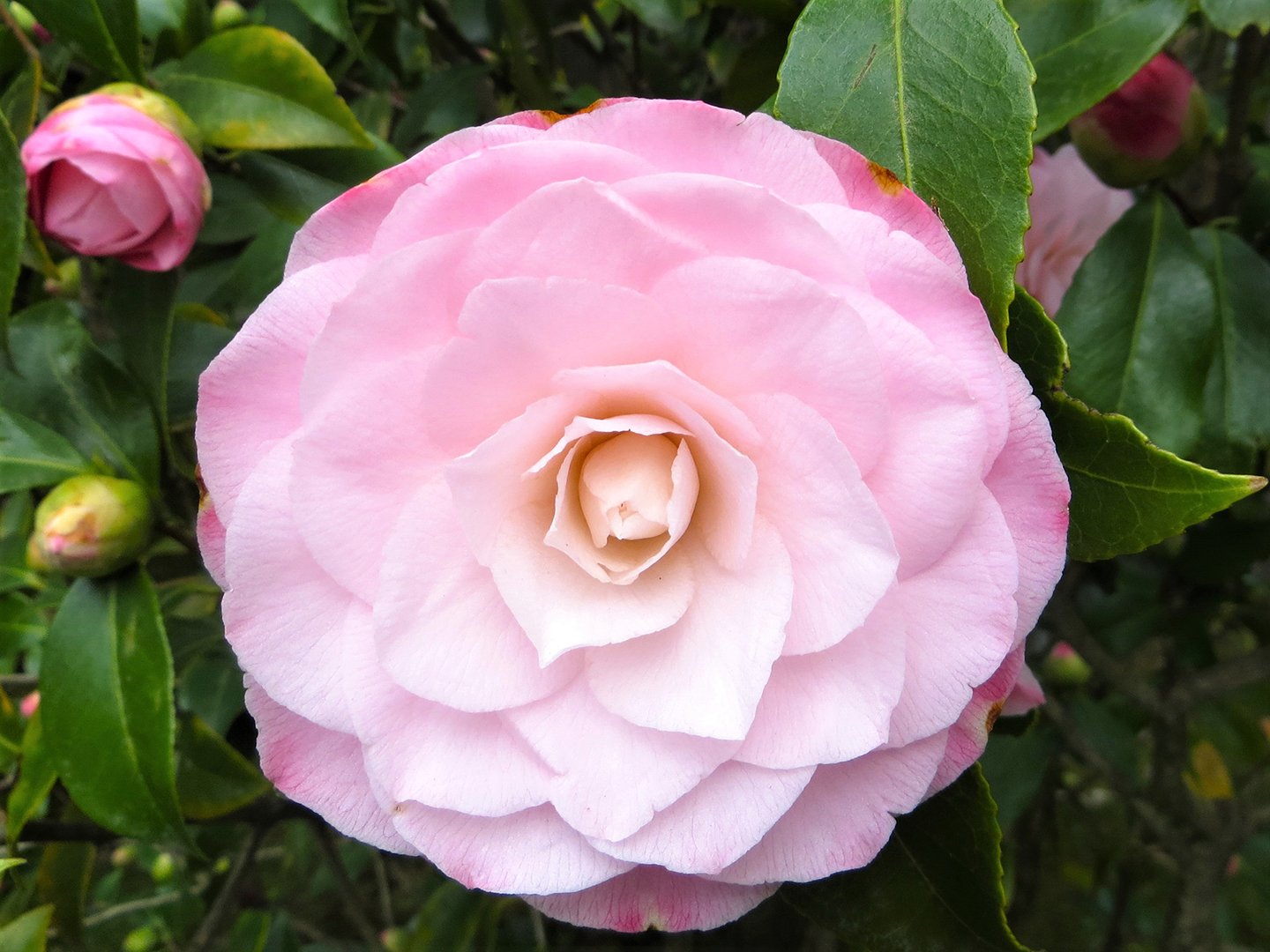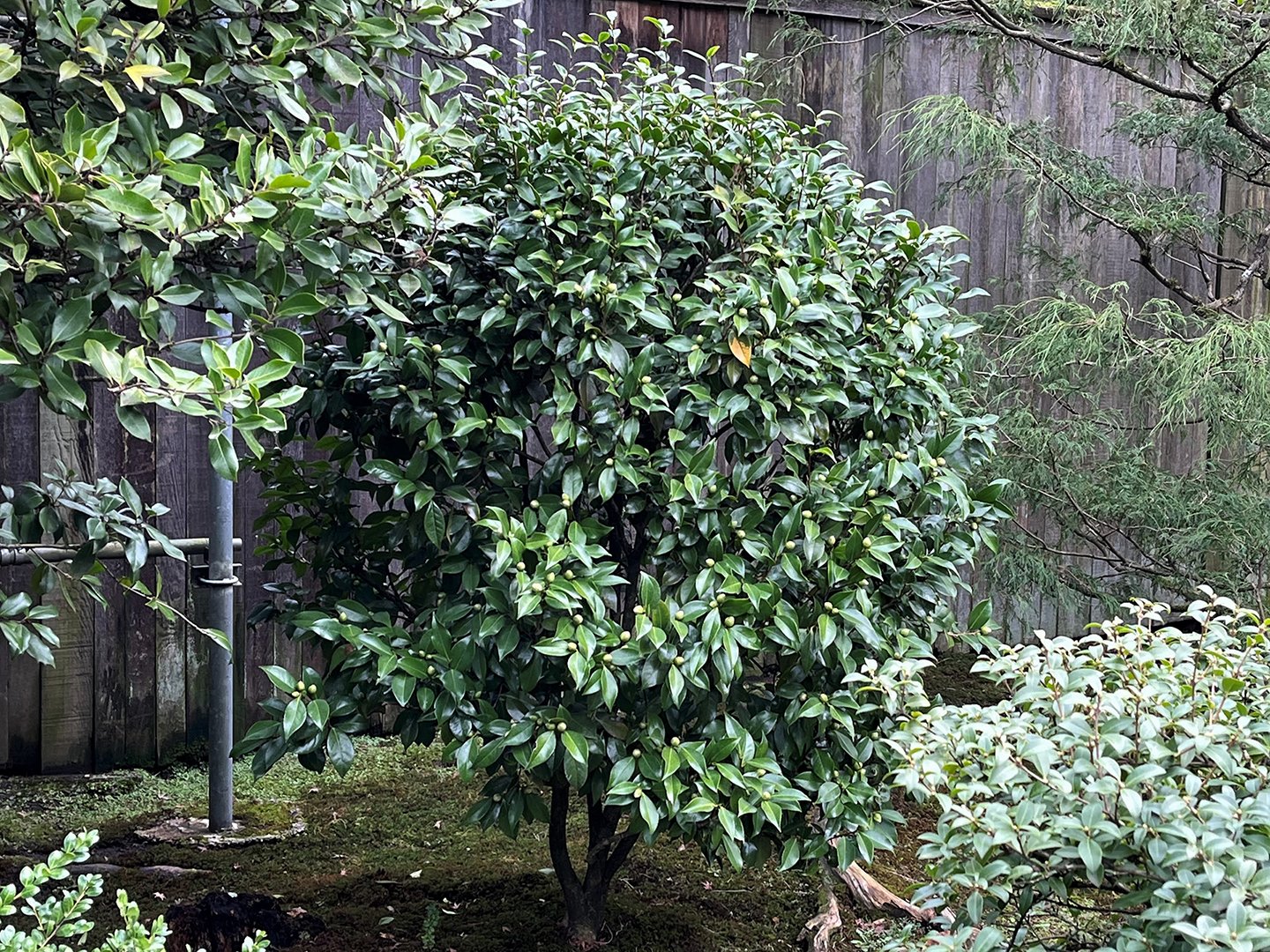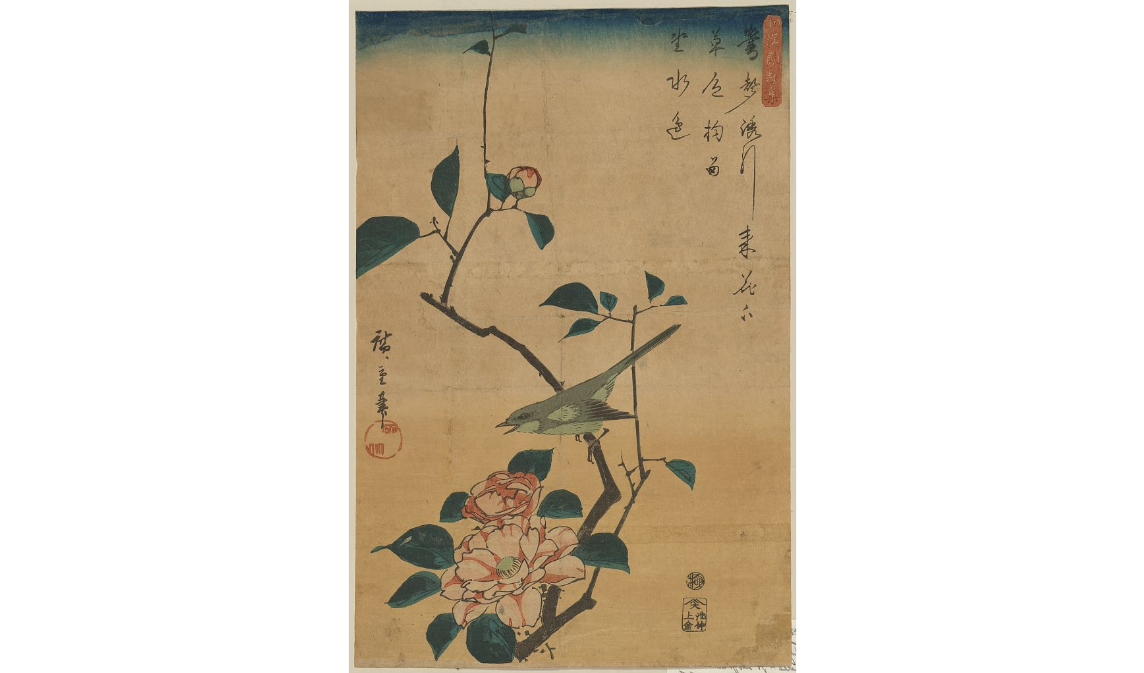A Japanese Camellia with Lovely Formal Double Pink Flowers, Opening in March
By Corinne Kennedy
The beautiful shell pink, formal double flower of the unnamed Japanese camellia cultivar located south of the Garden’s original gate. (photo: Aleks Monk, March 19, 2014)
The Seattle Japanese Garden is fortunate to contain many species and cultivars (cultivated varieties) of the genus Camellia. One of my favorites, with lovely, shell pink, “formal double” flowers, was planted in 2011 just south of the Garden’s original gate. It was probably derived from the species Camellia japonica (Japanese camellia), but unfortunately the cultivar name was not recorded when it was added to the Garden.
I’ll begin this article with a brief discussion of the genus Camellia and the various Camellia species planted within the Garden, followed by a long section about the most well-known species, Camellia japonica. I’ll end by speculating about the identity of our unidentified “mystery” cultivar.
The Genus Camellia and the Camellia Species Planted in the Seattle Japanese Garden:
Camellia is a genus of magnificent flowering evergreen trees and shrubs, included within the tea family (Theaceae).1 There are more than 200 Camellia species, native to southern China and other areas of Southeast Asia, including Japan. Many centuries ago, both countries undertook the cultivation and breeding of camellias—not only for the beauty of their flowers but also for the teas produced from their leaves and the oils pressed from their seeds.
Camellias are important evergreen elements within the Seattle Japanese Garden, with four species planted here. Camellia japonica (Japanese camellia, which begins blooming in late winter or early spring) is the most important, with more than twenty plants. The Garden’s next most common species, with eight plants, is Camellia sasanqua (sasanqua camellia, which begins blooming in autumn). All the plants of both species appear to be cultivars, not their wild species parents, but the names of some were never recorded. The Garden also contains one Camellia japonica subspecies rusticana (snow camellia, blooming in March), one Camellia sinensis (tea camellia, blooming in late summer), and one Camellia oleifera (tea-oil camellia, blooming in October).
—
1 The word Camellia derives from that of a Jesuit missionary, Georg Joseph Kamel, whose descriptions and drawings of a species native to the Philippines were published in 1704.
Camellia japonica:
Camellia japonica (Japanese camellia, also known as common camellia) is a small broadleaf evergreen tree native to the milder regions of Japan, South Korea, Taiwan, and China. In Japan, where it’s known as tsubaki, it’s most often discovered growing in mountain forests. The wild form is variable, but with time it often attains a height of 30 feet, with an upright to spreading habit and a somewhat uneven appearance. The bark is smooth and gray, and the evergreen leaves are oval, dark green and glossy, with finely-toothed margins. Flower buds form in the fall and open in late winter or early spring. The cup-shaped blooms are typically red (occasionally pink or white) and single in form, with five or six petals. In their center is a broad mass of golden stamens. Fruit capsules are rounded and green, becoming purplish-red and woody when ripe. Plants with this simple “wild” form are greatly valued in Japan, where they’ve been planted in public and private spaces.
In both China and Japan, cultivation of this important species dates back more than a thousand years. Initially, plants with larger, showier flowers were developed to grace temple gardens and the homes of the nobility. Over the centuries more than 20,000 cultivars have been developed, with flowers characterized by an ever-expanding range of color and form. In the early 1700s, Camellia japonica was brought to the West, and soon became popular in Great Britain and Europe, where it was declared “the Queen of the Winter Flowers.” It was introduced into the United States later in that century, and into Australia and New Zealand in the 19th century. Breeding efforts have spread throughout the temperate world, continuing into the present.
Most cultivars of Camellia japonica have oval, 3-4 inch long, glossy dark green leaves with finely serrated margins. Though some are columnar in habit, most are broadly upright, in time attaining the stature of small trees. At maturity, they tend to be taller and stockier in habit than sasanquas, with showier flowers and foliage that is usually larger, wider, and leatherier in texture.
The Camellia japonica cultivar located just south of the Seattle Japanese Garden’s original gate. (photo: Corinne Kennedy, February 2023)
Japanese camellias are also much hardier than Europeans originally believed—most to USDA Zone 7 (minimum temperature about 5 degrees Fahrenheit). Nonetheless, they need careful siting. They require moist, well-drained, humus-rich, acid to neutral soil, and grow best with shade during the hottest part of the day. Shallow-rooted, they’re sensitive to drought as well as strong winds, and need protection from the root competition of nearby plants, groundcovers as well as trees and shrubs. They should not be planted in an east-facing location, where their winter or early spring flowers will be damaged by morning sun when temperatures are below freezing. They take well to pruning and training—to control their size or to create a variety of forms, including espalier (plants trained into a single plane, supported against a wall or other structure). Pruning is best done after flowering but before flower buds are set in late summer or early fall.
Camellia japonica has flowers of good substance 2—a major factor in the breeding of cultivars with beautiful, very showy, long-lasting blooms. Depending upon the cultivar, flowers are usually produced in late winter or spring, but their size and color can vary considerably depending on growing conditions, season, and the age of the plant..
Breeders’ goals have included developing intricate flower forms with many petals and unusual color variegations (multiple colors and patterns). The English terms for these forms are single, semi-double, anemone form, peony form, double, and formal double. The latter, which describes the unnamed cultivar south of our Garden’s original gate, is defined as follows:
“Many rows of flat, cupped or recurved petals, overlapped in symmetrical form, usually with central cone of tightly furled petals; in some cultivars petals arranged in layers, giving a hexagonal or perfect spiral appearance.” (Stirling Macoboy, The Illustrated Encyclopedia of Camellias, 1998)
“Tsubaki ni uguisu”: a bird on a tree branch, above a Camellia japonica blossom. (image: Utagawa Hiroshige, woodcut print from about 1840, Library of Congress Japanese Fine Prints and Drawings)
—
2 The substantial flowers of Japanese camellias drop off whole, rather than as single petals, often completely covering the ground. This lovely sight is known as ochitsubaki and has long been celebrated in haiku poetry. In general, breeders consider the shedding of whole flowers to be an asset—flowers are long-lived both on the plant and in the vase. Historically, though, the samurai viewed this characteristic as unlucky, and didn’t permit tsubaki to be planted at their homes. They were often required to behead outlaws, and tsubaki’s fallen flowers were thought to resemble the falling heads.
As shown above, tsubaki flowers have long been represented in the arts of Japan—for example, in woodcut prints. As ornamentals, Japanese camellias were planted in traditional Japanese gardens, in parks as hedges and shade trees, and in temple gardens. Cut stems with tsubaki flowers continue to be used in the traditional art of ikebana.
Our Garden’s “Mystery” Cultivar, located South of the Garden’s Original Gate
The pointed, deep green leaves and round flower buds of our Garden’s “mystery” cultivar. (photo: Corinne Kennedy, Feb. 2023)
Our Garden’s “mystery” camellia, located south of the original gate, begins blooming in March. It has lovely 3 - 3 ½ inch wide, soft shell-pink, formal double flowers, with pointed petals. The deep green, graceful foliage is narrow, toothed, and pointed at the tips.
After becoming a Garden Guide in 2013, I speculated that this attractive plant might be Camellia japonica ‘Pearl Maxwell’, which was developed by Mrs. C. O. Maxwell of Reno, GA, and registered in 1949. ‘Pearl Maxwell’ has soft pink or blush white, formal double flowers with pointed petals and a form that has been described as tidy, geometric, and symmetrical.
Camellia japonica 'Pearl Maxwell' (photo: Monrovia Nursery)
I had previously worked as a retail nursery’s tree and shrub buyer and knew that ‘Pearl Maxwell’ was being grown by wholesale nurseries that supplied camellias to our area’s retail outlets. Despite the huge number of cultivars that have been developed over the centuries, only a tiny percentage are available locally or online each year.
The formal double flower of our plant also resembles that of another locally available cultivar, Camellia japonica ‘Nuccio’s Pearl’, which was registered in 1979 by Nuccio’s Nursery, a well-known California breeder and grower of camellias. Its flower is also a formal double, and similar in size, but its color is described by the Atlantic Coast Camellia Society as “white washed and shaded orchid pink.”
Although it’s fun to speculate, the identity of our plant doesn’t really matter. Both cultivars are great plants with beautiful flowers, and there are also other, less available cultivars with similar blooms. Currently, ‘Nuccio’s Pearl’ appears to be more available in our region, yet readers who are attracted to our plant’s delicate, pale pink, formal double flowers will probably be happy with either one.
[Note: This article is an adaptation and expansion of a 2017 blog article about Camellia japonica and several other cultivars.]
Corinne Kennedy is a Garden Guide, a frequent contributor to the Seattle Japanese Garden blog, and retired garden designer.





